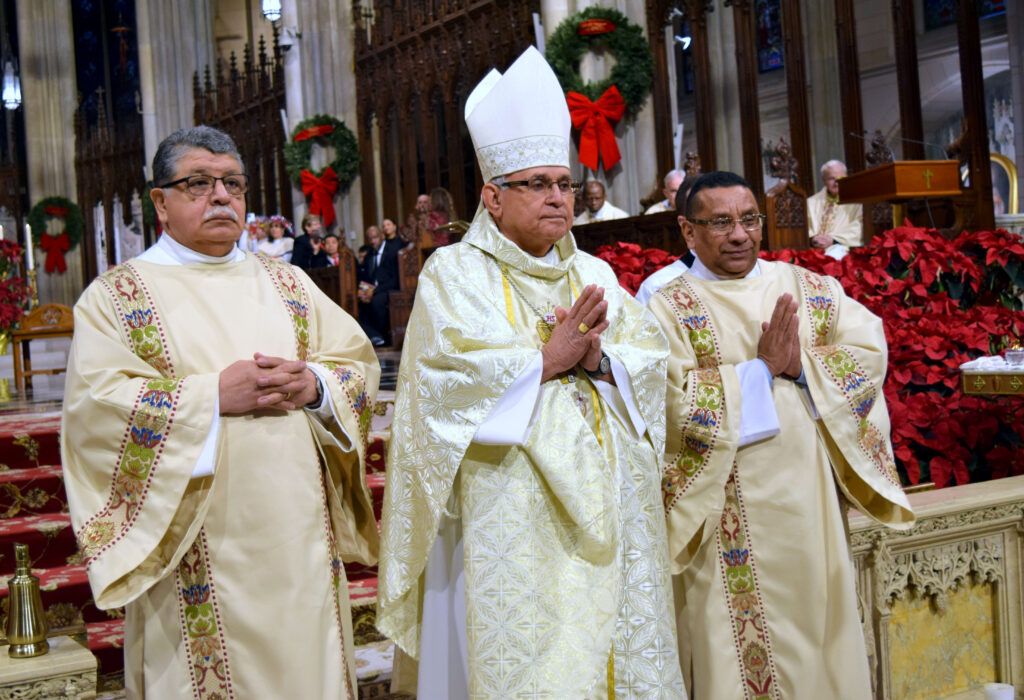
At Christ of Esquipulas Mass, Guatemalan Cardinal Calls for Peace, Unity
By: Armando Machado
“We have a big challenge – the big challenge of all of us feeling as citizens of this same country (Guatemala), even though we speak different languages and we have different customs”

Cardinal Álvaro Leonel Ramazzini Imeri of Huehuetenango, Guatemala, spoke to the faithful at St. Patrick’s Cathedral about “the mission of the Church: to evangelize, to announce the Good News of the Gospel, so that there we can find the truth, we can find the foundation for a life that is honest, a life that is responsible.”
“Brothers and sisters, good afternoon – a very special greeting to all of you, especially those who made the entrance procession,” Cardinal Ramazzini said at the start of the annual Christ of Esquipulas Mass, Sunday, January 7, referring to the colorfully-clad participants of the procession who were dressed in Guatemalan traditional garments.
The cardinal, who served as principal celebrant and homilist, then expressed his gratitude to the archdiocese for allowing the Mass at the cathedral each year. Christ of Esquipulas [also called Lord of Esquipulas] is a Guatemalan devotional tradition.
Later during the homily, Cardinal Ramazzini spoke briefly of Guatemala’s “sad history,” of armed conflict, “with so many deaths, so much persecution, especially of those who defended justice and truth.” [The Guatemalan Civil War started in 1960 and ended in 1996, after negotiations between the government and rebels concluded].
The cardinal spoke of the importance of celebrating his beloved country’s multicultural, multiethnic, and multilingual society. “And there we have a big challenge – the big challenge of all of us feeling as citizens of this same country (Guatemala), even though we speak different languages and we have different customs.”
Cardinal Ramazzini noted that in the days leading to the Mass, at New York parish gatherings, he met with fellow Guatemalans, during which he told parishioners, “Please do not let your sons and daughters forget their roots; do not let them forget the language of their ancestors.” The cathedral Mass was conducted in Spanish; the day’s readings were spoken in Spanish and two indigenous languages of Guatemala.
In citing the first reading, from Isaiah 60, on the Epiphany of the Lord, “a message of hope,” he spoke of the significance of Christ of Esquipulas, a very important devotional tradition in Guatemala.
“In Guatemala, as in other countries, poverty is the result of injustice,” he said, noting the importance of maintaining hope for Guatemala, such as the hope mentioned in Isaiah 60. Citing a September message from Pope Francis, he said that one has a right to migrate, but one also has a right not to migrate, “when your country gives you what you need to live with dignity.” And the cardinal spoke of the word “searching,” as in the Three Wise Men searching for the Christ Child. “And I ask you: “Do you search in your lives for Jesus Christ the Lord?” Cardinal Ramazzini said, adding that for him the answer is in Christ’s words (Matthew 25) when the Lord said: “For I was hungry and you gave me food, I was thirsty and you gave me drink, a stranger and you welcomed me…Whatever you did for one of these least brothers of mine, you did for me.”
As for current dire events, Cardinal Ramazzini said, “I am thinking of – this is something that I carry here in my heart – the people who suffer in the Gaza Strip; the people who suffer in Ukraine, the people who suffer in Nicaragua.”
The city of Esquipulas is located in southeast Guatemala. It is known for its large colonial church (the Basilica of Esquipulas), a popular pilgrimage center in Central America built in the 18th century to house the Black Christ figure of Jesus on the cross. The figure was commissioned by the Spanish conquistadors and first placed in a local church in 1595.
The image was carved from dark wood in 1594, measuring around five feet tall. The main religious processions occur on January 15 and during Holy Week. Esquipulas is approximately 80 miles east of Guatemala City, with an elevation of over 3,000 feet. The basilica dominates the horizon.

